Byculla's Victoria Road bears treasures from benevolent Jewish, Parsi, Christian and Muslim city fathers
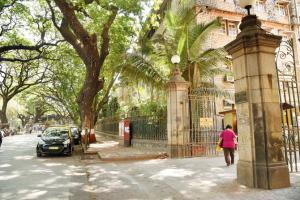
The entrance to Rustom Baug, built by Jerbai Wadia in memory of her son Rustom. The construction of the colony with 349 apartments was completed in the 1920s by her other two sons Sir Cusrow and Sir Ness Wadia
 Go with green, I tell myself. Writing about city precincts, I mentally assign each a colour to suit its story. Victoria Road gets green. Stronger reasons dictate the choice than the obvious canopy of trees shading this path east till Reay Road. The back gates of the botanical Victoria Gardens - Rani Baug or Jijamata Udyan zoo in the former "Garden Suburb" of Byculla - fall here. Verdure is suggested again by the street renamed Sant Savta Marg: Savta Mali was patron saint of the Mali (gardener) community running Byculla's vegetable markets.
Go with green, I tell myself. Writing about city precincts, I mentally assign each a colour to suit its story. Victoria Road gets green. Stronger reasons dictate the choice than the obvious canopy of trees shading this path east till Reay Road. The back gates of the botanical Victoria Gardens - Rani Baug or Jijamata Udyan zoo in the former "Garden Suburb" of Byculla - fall here. Verdure is suggested again by the street renamed Sant Savta Marg: Savta Mali was patron saint of the Mali (gardener) community running Byculla's vegetable markets.
The arboreal allusion continues at Dilip Salunke's Shri Sainath Flower Shop. Stringing garlands of fragrant buds as his grandfather Govind did, he says, "We've survived on Rustom Baug and Jer Baug," saluting the Parsi colonies across. "I'm best stocked at Muktad," he adds, referring to the last fortnight of the Shahenshahi Zoroastrian calendar, commemorating departed ancestors before New Year dawns.

Dilip Salunke at Shri Sainath Flower Shop introduced by his grandfather in 1930. Grateful for business from Jer Baug and Rustom Baug, the florist can reel off perfectly pronounced, significant holy days of the Zoroastrian calendar month, when torans he strings hang at every door
Salunke sits alongside Gloria Restaurant and Stores, at the corner of century-old Alexandra Terrace. Opposite, the slim spires of recently restored Gloria Church trace a lace in the sky. Built at Mazagaon in 1632 by Portuguese Franciscans, it rose, delicately English Gothic, at the present site from 1911. Gloria Church helmed the Padroado section of Catholicism in Bombay from 1887 to 1928.
Portuguese for "patronage", Padroado implied the King's privilege in nominations of high ecclesiastical office. Among a fistful of their faith left in the locality (20,000 parishioners in the 1970s dipping to 3,000), Margaret and Conrad Fernandes of Victoria Cross Lane 3 recall how even within their large church, the congregation overflowed outside. "No room to fit children of Our Lady of Glory parish meant us peering through the carved communion rails. We crouched behind, awed by fire-and-brimstone sermons," says Margaret. In the 1960s, her sisters played the pipe organ Germany gifted Gloria Church in 1913. This is not among the three operational of Bombay's five church organs.
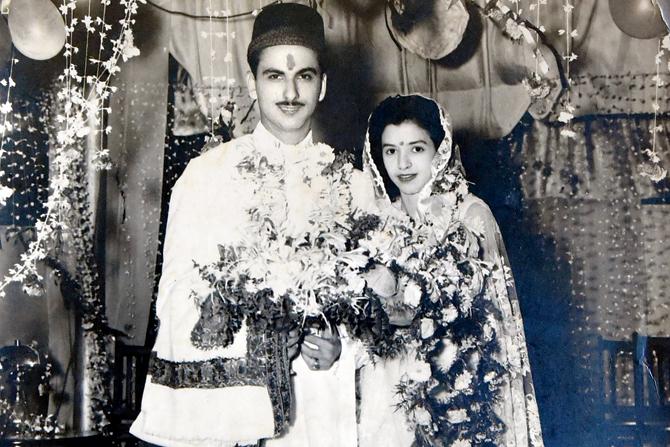
Cricketer Mehli Irani and his wife Dhun on their wedding day in 1955. Their marriage was the first function on the Rustom Baug pavilion grounds. Pic Courtesy/Mehli Irani
The couple describes "a big family of Byculla Christians" celebrating feasts. Youngsters went house to house singing carols the week before Xmas and Santa sat in a parked convertible packed with gifts in the Alexandra Terrace compound.
The Fernandes' hallway displays the figurine of a familiar little lady. The polka dot-skirted Amul Girl stands beside her framed creator, adman Eustace Fernandes, who was Conrad's brother. "Our Lane 3 also produced world-class musicians," says Conrad, listing voice trainer Patricia da Cunha, pianists Gavin Martin who performed with Zubin Mehta and Rex Lobo, music director of the cult stage productions Godspell and Jesus Christ Superstar.
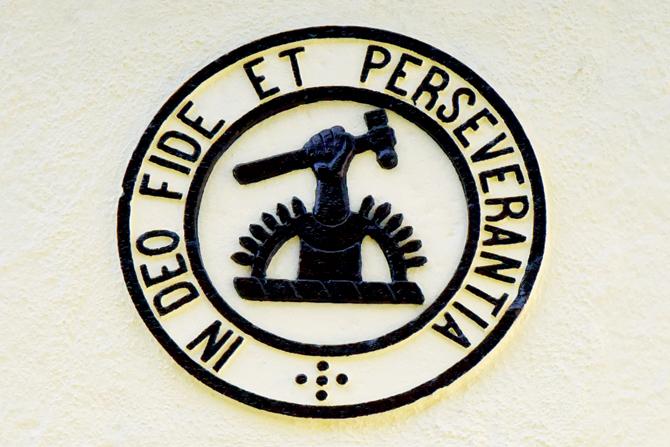
The facade of each block in this baug has the Latin phrase "In Deo Fide Et Perseverantia (Faith in God and perseverance)" circling a symbol which was the registered trademark of Nowrosjee Wadia & Sons
They were all born in Eugenie Maternity Home, just ahead. So were soprano queen Patricia Rozario, the redoubtable Julio Ribeiro and Bishop Ignatius Lobo. Dr FJ Sequeira opened the popular nursing home in the 1920s, naming it after his wife, Eugenie. Their son, renowned gynaecologist Dr Eustace Sequeira, carried it forward till the 1980s. Between them, they delivered three generations of babies here. Denzil Sequeira, Dr Eustace's son, was a leading fashion photographer of the 1980s-90s and actress Diana Penty is Dr Eustace's granddaughter.
The stately Renaissance-style mansion that is Masina Hospital was Sans Souci, the 19th-century palace of Baghdadi Jew trader and city father David Sassoon. It hosted glittering evenings in the 1870s and 1880s. A party announcing India's transfer to the Crown had Lord Elphinstone among the cognoscenti, but December 1889 saw Sans Souci welcome a huge gathering of Indian National Congress delegates.
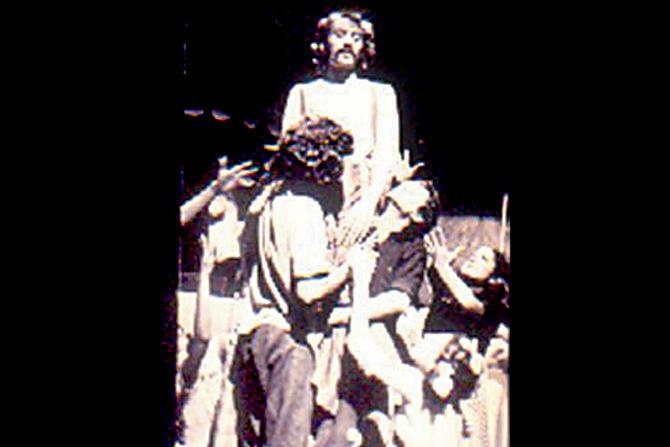
Still from Pearl Padamsee's Godspell, 1973, showing Victor Banerjee as Christ and Sharon Prabhakar. The music director of this first, of three, Godspell productions, was pianist Rex Lobo who grew up in Victoria Cross Lane 3. Pic/Raell Padamsee's Ace
The Sassoons' riding ground was the zoo - which, too, was donated by them -evident from its rear gate facing Masina Hospital, through Cross Lane 2. Apart from distressed elephants trumpeting in the sick bay, the road's residents occasionally contended with territorial hazards like an escaped python and a lion on the loose.
What led the Sassoons to have their residence transform to a hospital? When Dr Hormasji Masina, a Fellow of the Royal College of Surgeons, satisfactorily cured Sassoon's acute hernia problem, he was given the grand property for Rs 25,000. Apportioning public contributions that generously streamed in, Masina became Bombay's first private hospital in 1902, followed by Parsi General Hospital and then Harkisondas Hospital.
Sassoon's grandson, Jacob, lived at Braganza Hall, where Lady Marie Willingdon introduced rehabilitation for World War I-injured Indian soldiers in 1917. Queen Mary's Technical Institute taught self-supporting skills to an inaugural batch of 25 men rendered unfit for military duties.
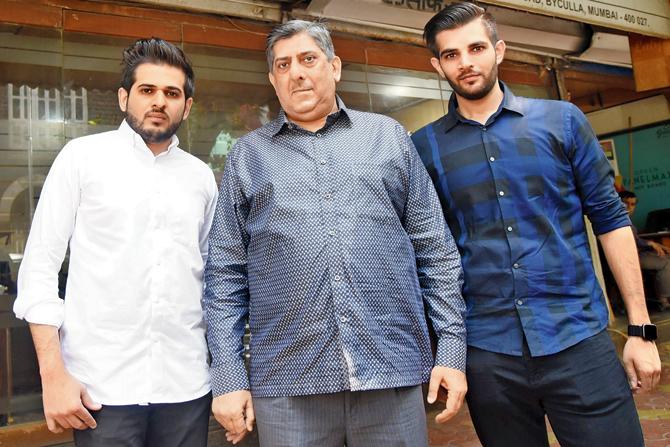
Mohamed Ali Latiff, partner at Latiff Sons, with sons Mobin and Moin outside the family's 1901-opened shop. Timber establishments like theirs line the Mustafa Bazar side of the street. Pics/Suresh Karkera
Masina Hospital is flanked by Jer Baug's northmost gate and the sprawl of Rustom Baug, constructed by Jerbai Wadia in memory of her son Rustom. The vast spread of Sassoon properties is seen from the identical patterned railing that skirts the distance from Gloria Church to the farthest gate of Rustom Baug.
Block 5 was the colony's first in 1923, from where Rustom Jasoomoney attended Anza, as Antonio D'Souza School next to the church is called. He misses the seekh-botiwalla outside Best Restaurant and pranks played on illegit Victoria passengers. Kids hopped on for free, hanging from the axle rod behind the carriage. When naughty buddies tattled, yelling "Chabook", the hitchhikers were slapped by backward whiplashes from the alerted hackman.
"Rustom Baug hasn't scored in sport," laments nonagenarian Mehli Irani, left-handed batsman and wicket keeper distinctively playing in the Kanga League for over 50 years. "We were diffident competing outside the colony. Catholic boys beat us hollow in football, though we did have good badminton players like the Katpitias. I tried to promote my game - flattening the ground, planting grass, installing lights to make day and night cricket possible."
Fashion fares better on the Sir Ness Wadia Pavilion where Rustom Baug throws the May Queen Ball on the last day of April. Heralding summer, this cosmopolitan pre-Independence formal dance has turned a fundraiser pageant for Zoroastrian women participants across India.
The loveliest rain tree on Rustom Baug's central lawn shades children chasing butterflies, squirrels sipping water and hooting night owls. Faint murmurs from the enclave's seniors claim a white-clad bearded horseman strode this maidan, a rumour fuelled by earlier graves on the premises. Hearing these could be Armenian, I check with Zabel Joshi, the city's sole Armenian. While the graves at Rustom Baug may or may not have been Armenian, five Armenian-inscribed tombstones from 1767 lay at 9 Victoria Road - confirmed by Mesrovb Jacob Seth's book, Armenians in India, my Bombayphile friend Vinayak Talwar shares.
The cross lanes were riddled with contrasts. Prohibition years witnessed drunken brawls and stabbings in speakeasies at spots close to Kharwa and Chandi gullies. In the Lane 3 courtyard of Balaji Hospital, once a maternity home, is a bust of Kamarkhanum, daughter of the illustrious clan of Baronet Currimbhoy Ebrahim. More serenity waits at the Woodstock bungalow with charming original balcony grills.
Rustom Baug romances bloomed beyond its walls at haunts like Jaffer Book Stall, now a printing service. Jaffer Khilawala started the circulating library after selling hand-churned ice cream in the 1940s. The acknowledged King of Comics stocked piles of these with Mills & Boon titles. "Dad remembered regulars by membership numbers," says Jaffer's son Zulfikar. "At their weddings he'd exclaim, 'Arre, our No. 120 is marrying No. 130!'"
Several nuptials were solemnised on the terrace of a modest hotel, intended as a ladies' hostel. Picasso-inspired artist-architect Jehangir Vazifdar (the prolific painter chose never to sell any canvas) opened it as Hotel Heritage. "In 1968 Byculla, middle class families welcomed this smaller, affordable place," says his son Phiroze. The Vazifdars brought in Hoshang Dorabjee of Poona to cater at Parsi Palace, the specialty cuisine restaurant Arab guests especially enjoyed.
Tucked deep in Cross Lane 2 are the vintage delights of Dotivala Garage. His great-grandfather Erachshah having opened it in the 1920s, Hervesp Dotivala supervises work on some stunners on wheels. Buffed and beautified, the afternoon I go are a 1919 Overlander, 1937 Riley, 1947 Armstrong Siddeley and wood-bodied 1961 Willys Jeep between a bright blue 1950s Chrysler and fiery red 1960s Impala.
Out on the main road stand Mustafa Bazar's timber depots and sawmills, where merchants like Farouk Sodagar flourished. It was believed: "Bazar e Mustafa, kharidar e Khuda - Name this market after Prophet Mohammad and Allah will send customers." In communally volatile times, this was the scene of brutal burnings. With terrible flames went up fervent prayers to restore the mohalla's peace.
At 1901-established Latiff Sons, inherited from his great-grandfather Abdul, a proud Mohamed Ali Latiff recounts an act of kindness. His grandfather Abubaker phoned the shop daily around noon in the 1930s (on their number lengthened to 4860 from 60), enquiring after his day's business as well as other shops'. Those struggling with sales were invited to the Latiff backdoor to buy quality logs at cost price.
Touched by that tale of quiet charity, I revisit the statue of Jerbai Masina, the doctor's wife, fronting the hospital. It bears a soothing line, condensed from Longfellow's verse: "There is no death, what seems so is transition, from breath to Life Elysian." Sun winks on the words, as if warming their wisdom. A reminder of profundity and philanthropy entwined on Victoria Road.
Author-publisher Meher Marfatia writes fortnightly on everything that makes her love Mumbai and adore Bombay. You can reach her at mehermarfatia@gmail.com/www.mehermarfatia.com
Catch up on all the latest Mumbai news, crime news, current affairs, and also a complete guide on Mumbai from food to things to do and events across the city here. Also download the new mid-day Android and iOS apps to get latest updates
 Subscribe today by clicking the link and stay updated with the latest news!" Click here!
Subscribe today by clicking the link and stay updated with the latest news!" Click here!









